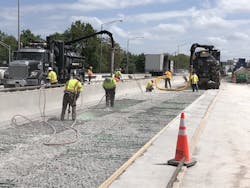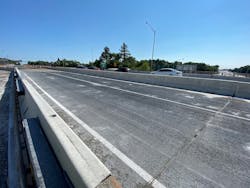Use of ultra-high performance concrete on the Commodore Barry Bridge
Transportation agencies seeking effective asset preservation and rehabilitation strategies may want to monitor a demonstration project underway on the East Coast, where the Delaware River Port Authority (DRPA) is executing the country’s largest bridge deck overlay application of ultra-high performance concrete (UHPC) on the Commodore Barry Bridge.
“We owe it to ourselves and our customers to safely explore new technologies like UHPC,” said Michael Venuto, P.E., PLS, DRPA’s chief engineer. “Looking into this material is a worthwhile endeavor. It has the potential to reduce costs, schedules and traffic impacts.”
The DRPA is rehabilitating the bridge deck on a deck truss span and a girder span on the 1974 cantilever bridge by removing the upper portion of the existing deck slab and reconstructing it with UHPC. If the test is successful, a full-scale application could save the DRPA more than $200 million in capital costs and extend the life of the bridge deck by 30 years or more.
New to bridge repair
States have used UHPC successfully in accelerated bridge construction, but its application in bridge deck repair is new. Despite the Federal Highway Administration’s Turner Fairbanks Research Center championing the use of UHPC in overlay applications, owners have been cautious to adopt it because the contractor community is unfamiliar with the material, and costs are substantial. The DRPA selected test locations, totaling nearly 28,000 sq ft at a cost of $134 per sq ft. Venuto said a full-scale application could drop the price to about $100 per sq ft.
Still, UHPC’s unique characteristics are difficult to ignore. Transportation agencies in Europe report multiple benefits, including long-lasting performance, durability, and superior strength.
“Ordinary concrete typically has a compressive strength of 3,000-5,000 psi,” said Robert Bistline, P.E., project manager for HNTB, the engineer of record for the Commodore Barry Bridge project. “UHPC has a strength of 18,000-24,000 psi. It’s incredibly strong and completely impermeable. A single layer can add significant strength to a bridge deck without adding dead load.”
When compared to traditional bridge redecking, UHPC has been shown to ease constructability, reduce construction timelines, eliminate costly framing modifications and minimize changes to dead load.
A viable candidate
After a deck condition assessment in 2018, the DRPA began studies to replace the Commodore Barry Bridge deck within 10 years at a cost of $300 million. In the interim, the Authority implemented a traditional bridge deck preservation project to maintain the deck in serviceable condition until replacement could be completed.
In 2020, the Authority, working closely with HNTB, moved forward with repairs but opted to include a UHPC test.
“UHPC must be applied at the right time in a bridge’s life cycle,” Bistline said, “before the bridge deck is too far gone. On the Commodore Barry, less than 10% of the bridge deck is delaminated, making it a viable candidate.”
Other factors solidified the Commodore Barry Bridge a viable candidate for UHPC. The bridge carries a high volume of commuter traffic between Pennsylvania and New Jersey. Its reversible lane configuration and moveable barrier help increase traffic flow during peak periods. Closing lanes for full deck replacement would disrupt the more than 14 million vehicles who use the bridge each year. Its 1 million sq ft of bridge deck, narrow width, five-lane configuration and existing structure framing pose other challenges to complete deck replacement.
Implementing the test
Application of UHPC in bridge deck repair is a straightforward process. The contractor uses water jets to remove the chloride-laden concrete and expose the existing reinforcement steel without damaging it. Crews use hammers to gain clearances around the rebar, and vacuum trucks perform the final deck preparation and cleanup.
Meanwhile, the contractor batches and mixes the UHPC directly on-site. Large sacks containing premeasured UHPC dry materials are dumped into the mixer with the appropriate amount of water. Once the dry materials and water reach the right consistency, the contractor adds a large sack of steel fibers.
“UHPC is made of portland cement, fine aggregates of quartz and sand and hair-like metallic reinforcing fibers,” Bistline said. “It resembles a Brillo pad dipped in pancake batter.”
For a deck repair, the UHPC mix must be stiff enough to stand up to the grade and cross slopes, but fluid enough to flow into all the nooks and crannies when vibration is applied.
Because achieving the right consistency is a skill and essential to the project’s success, the contractor was required to demonstrate his ability to mix and place the UHPC material before the project began.
“If you put the material down incorrectly, it could be a real challenge to get it back up,” Bistline said. “That’s why we do the mock tests, and why we have a UHPC manufacturer representative on-site overseeing the mixing operation.”
Each batch is tested for quality and consistency before it is transferred by backhoe and self-propelled buggies to the bridge deck. As the paste-like mixture is poured onto the exposed rebar, concrete workers vigorously spread it out ahead of a vibratory screed. After the screed passes, they visually inspect the fresh layer of UHPC and add finishing touches. Similar to the curing process of traditional concrete, workers apply a curing compound and vapor barrier and finish it with a diamond grind for a smooth, safe surface.
“Within 24 hours, the material reaches a strength equal to a carbon steel plate,” Bistline said.
Venuto said the project should be completed by the end of this year.
Evaluation and next steps
At the end of the one-year test, the Authority will drill core samples into the bridge deck and pull on the cores to see where they break.
“The goal is for the core sample to break somewhere within the original concrete deck. That will show the bond between the UHPC and the original concrete is stronger than the bond of the original concrete deck itself,” Bistline said.
The DRPA will consider results of its test along with other industry experiences before making a final decision about a full-scale deck application.


